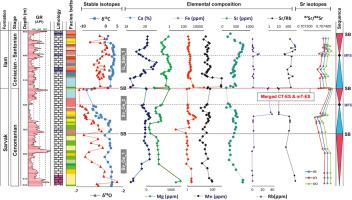Cretaceous Research ( IF 2.1 ) Pub Date : 2022-08-08 , DOI: 10.1016/j.cretres.2022.105329 Hamzeh Mehrabi , Amin Navidtalab , Hossain Rahimpour-Bonab , Ulrich Heimhofer

|
Providing a chronostratigraphic framework often is problematic in shallow-marine carbonates with poor biostratigraphic resolution. In such cases, an integration of geochemical, sedimentological, and paleontological data can be used to construct a reliable sequence stratigraphic framework. This study focuses on elemental concentrations and isotopic ratios of Cenomanian–Santonian (C–S) neritic carbonates in SW Iran used to construct a sequence stratigraphic framework, asses sequence ages and durations of hiatus. The diagenetic and geochemical expression of two paleoexposure surfaces, representing type-I sequence boundaries (SBs), are discussed. Increase in Fe and Rb concentrations and decrease in Ca content are recorded at and/or below distinct erosional surfaces. Mg content shows a facies-dependent response with former LMC (low magnesium calcite) or aragonitic facies showing increase while HMC (high magnesium calcite) indicates decrease in response to SBs. Mn shows considerable changes apart from sequence surfaces that are strongly facies dependent. Sr concentrations show an increase in HMC and decrease in LMC in samples which experienced semi-closed meteoric diagenesis, far below the SBs. However, in samples characterized by open system diagenesis, directly underlying the SBs, Sr tends to decrease in all components. The Sr/Rb ratio is a reliable tool in detecting erosional SBs, shown as conspicuous negative excursions. C (carbon) and O (oxygen) isotopes show distinct negative excursions at erosional SBs and a slight increase at or around the MFSs. The 87Sr/86Sr ratio shows clear positive excursions at SBs probably due to 87Rb decay in incorporated aluminosilicate detritus, which makes it as the most reliable proxy for the detection of SBs in the studied sections. Two main erosional SBs are marked by 87Sr/86Sr ratios including the CT-ES (Cenomanian–Turonian boundary exposure surface) and mT-ES (middle Turonian exposure surface) with hiatus durations of 0.53 and 2.7 Myr, respectively. These paleoexposure surfaces are correlated with other neritic sections of C–S sequences in SW Iran.
中文翻译:

层序地层表面的地球化学表达:以伊朗西南部新特提斯东南缘上白垩统浅水碳酸盐岩为例
在生物地层分辨率较差的浅海碳酸盐岩中,提供年代地层框架通常是有问题的。在这种情况下,地球化学、沉积学和古生物学数据的整合可用于构建可靠的层序地层框架。本研究侧重于伊朗西南部 Cenomanian-Santonian (C-S) 浅海碳酸盐的元素浓度和同位素比率,用于构建层序地层框架,评估层序年龄和中断持续时间。讨论了代表I型序列边界(SBs)的两个古暴露表面的成岩和地球化学表达。在不同的侵蚀表面处和/或下方记录了 Fe 和 Rb 浓度的增加和 Ca 含量的减少。Mg 含量显示出与前 LMC(低镁方解石)或文石相显示增加的相依赖性响应,而 HMC(高镁方解石)表明响应于 SBs 减少。除了强烈依赖相的序列表面外,Mn 显示出相当大的变化。在经历半封闭大气成岩作用的样品中,Sr 浓度显示 HMC 增加而 LMC 减少,远低于 SBs。然而,在以开放系统成岩为特征的样品中,直接位于 SBs 之下,Sr 在所有组分中趋于降低。Sr/Rb 比率是检测侵蚀性 SB 的可靠工具,显示为明显的负偏移。C(碳)和 O(氧)同位素在侵蚀 SB 处显示出明显的负偏移,在 MFS 处或周围略有增加。这 除了强烈依赖相的序列表面外,Mn 显示出相当大的变化。在经历半封闭大气成岩作用的样品中,Sr 浓度显示 HMC 增加而 LMC 减少,远低于 SBs。然而,在以开放系统成岩为特征的样品中,直接位于 SBs 之下,Sr 在所有组分中趋于降低。Sr/Rb 比率是检测侵蚀性 SB 的可靠工具,显示为明显的负偏移。C(碳)和 O(氧)同位素在侵蚀 SB 处显示出明显的负偏移,在 MFS 处或周围略有增加。这 除了强烈依赖相的序列表面外,Mn 显示出相当大的变化。在经历半封闭大气成岩作用的样品中,Sr 浓度显示 HMC 增加而 LMC 减少,远低于 SBs。然而,在以开放系统成岩为特征的样品中,直接位于 SBs 之下,Sr 在所有组分中趋于降低。Sr/Rb 比率是检测侵蚀性 SB 的可靠工具,显示为明显的负偏移。C(碳)和 O(氧)同位素在侵蚀 SB 处显示出明显的负偏移,在 MFS 处或周围略有增加。这 Sr 在所有成分中趋于降低。Sr/Rb 比率是检测侵蚀性 SB 的可靠工具,显示为明显的负偏移。C(碳)和 O(氧)同位素在侵蚀 SB 处显示出明显的负偏移,在 MFS 处或周围略有增加。这 Sr 在所有成分中趋于降低。Sr/Rb 比率是检测侵蚀性 SB 的可靠工具,显示为明显的负偏移。C(碳)和 O(氧)同位素在侵蚀 SB 处显示出明显的负偏移,在 MFS 处或周围略有增加。这87 Sr/ 86 Sr 比值在 SBs 处显示出明显的正偏移,这可能是由于87 Rb 在掺入的铝硅酸盐碎屑中衰变,这使其成为研究部分中检测 SBs 的最可靠的代表。两个主要的侵蚀 SB 的标志是87 Sr/ 86 Sr 比率,包括 CT-ES(Cenomanian-Turonian 边界暴露表面)和 mT-ES(中 Turonian 暴露表面),中断持续时间分别为 0.53 和 2.7 Myr。这些古暴露面与伊朗西南部 C-S 序列的其他浅海剖面相关。


























 京公网安备 11010802027423号
京公网安备 11010802027423号